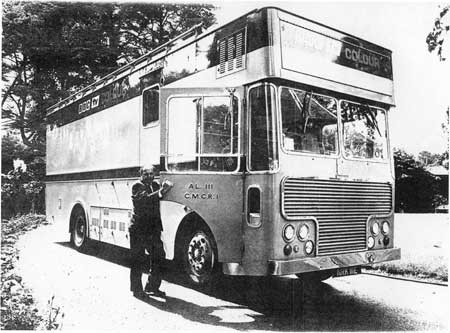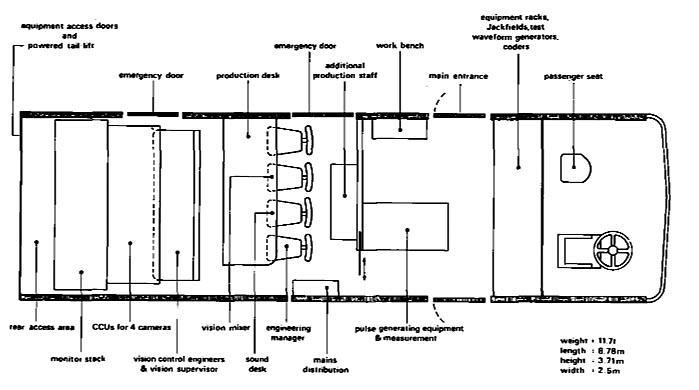BBC Colour Mobile Control Rooms
Since the very early days of television the BBC had put great emphasis on the value of outside broadcasts. One of the first major events was the Coronation of King George VI in 1937, which was accomplished using specially constructed mobile facilities based on coach chassis. We are not going to go into the whole story of the development of the outside broadcast unit, but by the 1960s the BBC had a fleet of 'Mobile Control Rooms' or less officially, 'Scanners' - BBC parlance for outside broadcast production vehicle (called 'Remotes' in the US.)
These mobile units were built mainly by Marconi or Pye, and comprised several camera channels, with associated pulse generators, vision mixer and sound control facilities. At this time there was no means of recording on site, the output being sent back to BBC studios by special co-axial lines rented from the Post Office, or microwave link. As videotape technology became available, a separate vehicle was used which contained the VTR facilities.
For anyone unfamiliar with broadcast TV practice, the operation of television equipment was a very highly specialised skilled area which required a large number of (mostly engineering based) staff. The TV camera that we are all familiar with was not a self contained unit, it was merely the 'head', containing the least amount of electronics necessary to limit size and weight. The camera operator does not have control of the electronic functions, but is concerned with the framing, focussing and artistic composition of the shot. The control of the lens iris, black level, gain and other parameters was the province of the Vision Control engineer, and (in the BBC) an Engineering Manager, who was responsible for the lighting and the co-ordination of multi-camera installations.
The control of the programme content was entirely separate from the engineering side, and the switching of camera sources, telecine or remote feeds on the vision mixing panel was performed by either the programme director or a vision mixer. Normally the director, production assistant and vision mixer along with specialised operators for caption generators etc. were in the Production Control area, which was a separate room in a studio, although not always in an OB vehicle.
The sound side of television, which is of course just as important as the vision, was under the control of the Sound Supervisor, who would normally operate the sound mixing desk. Other members of the sound department would install and operate microphones, operate booms and also use tape recording machines.
The sound department were also responsible for the communications facilities, which included many wired and radio talkback circuits, from all departments to operators, and also feeds of programme sound to monitors. The Sound Control area is always separate, as it requires acoustical insulation from the production and engineering areas.
A Mobile Control Room therefore had to contain a Sound Control Room, Production Control Room, and Vision Control area. In some cases the Vision Engineers were positioned lower down, under the viewing line of the production staff, in the same area. Another area could be designated the Vision Apparatus or Central Apparatus Room, following studio practice.
Even without actual breakdowns, which were common, engineers had to be on hand during productions to make adjustments and set up facilities to meet production requirements. The logistics of rigging cameras on different types of supports such as dollies, cranes etc, to change zoom lenses or extend unwieldy cables required a team of people to accomplish, so careful planning was needed, requiring site meetings and detailed scheduling of equipment and staff.
With the introduction of colour in the early 1960s, the amount and size of equipment needed increased. The camera channels in particular became more complex, and care was needed to ensure that temperatures were maintained as constant as possible to prevent drifting of delicate adjustments. For instance, an hour was required for line-up adjustments before each day's work, and these would usually need to be corrected during the day.
The first Colour Outside Broadcasts

The first BBC colour mobile control room- cmcr1, 1967.
The first three Colour Mobile Control Rooms (CMCRs) were designed and built by the BBC for the inauguration of colour in 1967. They were used for the first scheduled public colour broadcast, the tennis championships from Wimbledon.

Plan of Type 1 CM CR
CMCRS 1 to 3 were built using Albion Clydesdale chassis. They were similar to the previous MCRs in that the operators sat across the vehicle, and all the equipment was built into sub-racks which were designed to be de-rigged from the vehicle and taken into locations such as theatres etc. This was facilitated by the whole production monitor racks being arranged to slide out of the back of the vehicle on a powered tail lift.
This seemed like a good idea but in practice it was a hugely time consuming task and did nothing for the precarious reliability of the equipment. The de-rig concept was retained for the Type 2 series but was not actually used, so later designs did not include this facility.They were equipped with four Philips LDK3 cameras, but due to the BBC's 'Buy British' policy they were bought from 'Peto Scott', who were the UK agents for Philips. Later cameras were branded Pye, who were commercially involved with Philips. The UK designation of these cameras was PC60, and they used two standard MklV camera cables, which the BBC had in abundance, as there were too many connections required between head and control unit. Later the G101 cable used for the EMI and Marconi colour cameras became standard, and the Pye PC80s used in some Type 2 CMCRs were fitted with these.
The Type 1 incorporated sync pulse and test signal generators, a vision mixer which was a modified monochrome unit, and was designed to be capable of operating on either 625 PAL or 525 NTSC standards.
Very little seems to have survived about the Type 1 scanners, which were historically important. Even photographs of them are rare. Do you have any pictures, memories or information relating to them?

